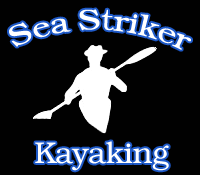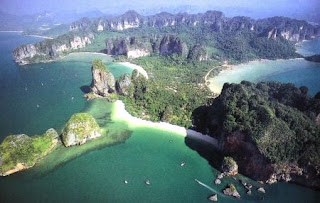
Sea Kayak
From Wikipedia, the free encyclopedia
A Sea kayak or touring kayak is a kayak developed for the sport of paddling on open waters of lakes, bays, and the ocean. Sea kayaks are seaworthy small boats with a covered deck and the ability to incorporate a spraydeck. They trade off the extreme maneuverability of whitewater kayaks for cargo capacity, ease of straight-line paddling, and comfort for long journeys.
Sea kayaks are now used around the world for marine journeys from a few hours to many weeks, as they can accommodate one or two (occasionally three) paddlers together with room for camping gear, food, water, and other supplies. The sport of sea kayaking (sometimes called ocean kayaking) combines much of the appeal of hill-walking with a maritime aspect, few access issues and a seemingly near unlimited area to enjoy.
History
Main article: Kayak
Contemporary sea kayaks trace their origins primarily to the native boats of Alaska, northern Canada, and Southwest Greenland. Wooden kayaks and fabric kayaks on wooden frames (such as the Klepper) were dominating the market up until 1950s, when fiberglass boats were first introduced. Rotomolded plastic kayaks first appeared in 1984.
Design
Modern sea kayaks come in a wide array of materials, designs, and sizes to suit a variety of intended uses. The primary distinction is between rigid kayaks and folding kayaks. While many modern kayaks carry the design features of traditional craft, recent design innovation includes:
Recreational kayaks, shorter sea kayaks with wide beams and large cockpits;
Sit-on-top kayaks, rotomolded boats without an enclosed cockpit, but with some other sea kayak features;
Inflatable kayaks, sometimes employing a rigid frame with inflatable sponsons; and
Surf skis, long, narrow boats intended for open ocean racing.
Size
Most production sea kayaks are between 12 feet and 24 feet in length, the larger kayaks often built for two (or in rare cases, three) paddlers. The width (beam) of typical kayaks varies from 18 inches to 28 inches, though specialized boats such as surf skis may be narrower. The length of a kayak affects not only its cargo capacity (for both gear and paddlers) but may also affect its "tracking" ability -- the ease with which the boat travels in a straight line. While other design features also impact tracking, very long kayaks are easier to paddle straight (and harder to turn). The width of a kayak affects the cargo capacity, the maximum size of the cockpit (and thus the size of the paddler in that cockpit), and (to a degree that depends on the design of the hull) the stability.
Material
Most rigid production kayaks are now made out of fiberglass, rotomolded polyethylene, or carbon-kevlar, there are more exotic materials, such as carbon fiber and foam core, and hand-built systems from as plywood or wood strip covered with fiberglass. Skin-on-frame kayaks are built on wood or aluminum frames covered in canvas, dacron or other fabrics, and may include inflatable tubes called sponsons.
Bow, stern, and deck
There are many design approaches for the bow, stern, and deck of kayaks. Some kayaks have upturned bows, with the intention of better performance into wave and better wave-shedding ability, while others aim to achieve this through increased buoyancy in the bow. Kayaks with unobstructed stern decks may ease certain types of self-rescue. Waterproof bulkheads in modern kayaks provide flotation in the event of capasize, and sea kayak decks typically include one or more hatches for easy access to the interior storage space inside. Kayak decks often include attachment points for deck lines of various kinds, which are aids in self-rescue and attachment points for above-deck equipment.
other
Many sea kayaks have steering gear or tracking aids in the form of rudders or skegs. In most cases rudders are attached at the stern and operated, via wires, from foot pedals in the cockpit. Rudders are typically retractable for beach landings. Skegs are straight blades that drop from a well in the stern of the boat. Both devices assist in paddling when a strong wind is coming from a direction other than directly in front.
Paddles
Sea-kayak paddles, and the associated paddling styles, fall into three basic classifications:
European: two roughly spoon-shaped blades at either end of a cylindrical shaft. This paddle style was developed for fast acceleration and sudden maneuvering in Whitewater kayaking, and then back-ported to sea-kayaking. Euro paddles can be made of aluminum, plastic or even wood, but the best are usually formed of more expensive materials like carbon-fiber for lightness. Often the two blades are feathered, or set at a right angle relative to each other (both for ergonomic efficiency, and so that as one blade moves backwards through the water, the opposite blade moving forward through the air presents its edge, rather than its face).
A European style kayak paddle, (a) top view, (b) axial view
Greenland: Relatively narrow blades which are rounded and full near the loom and blade roots, and becoming oval near the blade tips. Some paddles feature a "shoulder", or abrubt transition between the loom and blade roots. Greenland paddle blades are most often not feathered. Short Greenland paddles (generally one arm-span in length), called storm paddles, are used with a sliding stroke, where the hands are shifted along the blades for each stroke. Storm paddles are often used as spares and in very windy locations, as there is very little outboard blade to catch the wind.
A Greenland style kayak paddle
Wing: The blade of the paddle is shaped with a profile like a wing. When used with a special stroke, the blade actually produces lift as moves through the water, enabling the kayaker to produce more forward motion than with any other kind of paddle. The paddling technique is different from both European style paddles and Greenland style. It is most often used in racing, but also sees some limited use in recreational paddling such as touring.
Dimensions
Sea kayaks come in many different designs resulting in different dimensions. The length of a typical solo sea kayak can range anywhere from 12 to 18 feet (3.7m-5.5m) long, and tandem kayaks can range from 15 feet to 20 feet(4.6m-6.1m) long. Sea kayaks can range in width from 22.5 inches to 30 inches (57cm-76cm). Wider touring kayaks of 26 inches to 30 inches (66-76cm) are better for bigger paddlers, or small/average sized paddlers looking for more initial stability and manueverabality. Narrower beams of 22 inches to 25 inches (56cm-63.5cm) are good for small-medium sized paddlers who want more speed and less maneuverability. And lastly, kayak depth (or the height from the hull to the highest area of the deck) can range from 13 inches to 15.8 inches (33cm-40cm) high.
Trips
Weekend trips with overnight camping are popular amongst recreational kayakers, and many people combine kayaking with watching wildlife. Modern sea kayaks are designed to carry large amounts of equipment, and unsupported expeditions of two weeks or more are conducted in environments from the tropics to the Arctic. Expedition kayaks are designed to handle best when loaded, so it may be necessary to ballast them on shorter trips.
Notable expeditions
Franz Romer crossed the Atlantic Ocean in a kayak in 1928.
Oskar Speck paddled from Germany to Australia in 1932-1939.
Hannes Lindemann paddled, with the help of a sail, from the Canary Islands to the Caribbean in 1956. Documented in the book "Alone at sea".
Derek Hutchinson was the first to cross the North sea in 1976.
Nigel Foster and Geoff Hunter were the first to circumnavigate Iceland in 1977.
Frank Goodman was the first to circumnavigate Cape Horn in 1977.
Paul Caffyn was the first person to circumnavigate the South Island of New Zealand in 1977. He describes it in his book Obscured by Waves.
Paul Caffyn and Nigel Dennis were the first sea kayaker to circumnavigate Britain in 1980, a distance of 2,200 miles in 85 days
David Taylor and James Moore were the first to circumnavigate The Faroe Islands (mid way between Shetland and Iceland) in 1985.
Paul Caffyn was the first person to circumnavigate Australia in 1986 covering a distance of 9,420 miles (15 160 km)
Ed Gillet paddled from California to Hawaii in 1987.
Adventurer Chris Duff has circumnavigated both Ireland in 1996 and New Zealand's South Island in 2000.
Jon Turk and his team was the first to cross the Bering strait as they paddled from Japan to Alaska in 2000. Documented in the book "In the wake of the Jomon".
In his book Cold Oceans (1999), Jon Turk describes his solo circumnavigation of Cape Horn.
Peter Bray crossed from Canada to Ireland in 2001.
Trys Morris, Gemma Rawlings and Justine Curgenven successfully circumnavigated Tasmania in 2004. This journey is featured in This Is The Sea 2
Harry Whelan, Barry Shaw and Phil Clegg are considered to have been the fastest around Britain in 2005, completing the circumnavigation in 80 days
In November 2005 the first kayak circumnavigation of South Georgia in the Southern Atlantic was completed in 18 days, a distance of 600 km[1].
Eric Stiller and Tony Brown attempted circumnavigation of Australia. Described in the book Keep Australia on your left.
Safety
A sea kayak's primary safety device is its paddler. Some kayakers consider a well-practiced self-righting move such as an Eskimo roll to be essential to safe open-water kayaking, though this can be difficult in a heavily-laden boat. While there are a number of technique for unassisted righting and re-entry of a kayak after a capsize, most paddlers consider it safest to paddle with one or more others, as assistance is useful if attempting to roll up solo fails. Even if the assistance fails to get you righted, it's a lot easier to climb back into a boat in the open sea if you've got another boat and paddler to help and your boat's been emptied of water first. Nonetheless, experienced paddlers do attempt open water crossings unaccompanied, and several major long-distance kayak expeditions have been carried out solo.
There is a strong culture of self-sufficiency amongst sea kayakers and extensive safety equipment such as compass, towing lines, manual pumps, repair kits including wet application repair tape, flares, spare paddles, and survival gear are routinely carried; along with supplies of food and a flask of hot coffee for non-emergency use. GPS, charts, lights, radios and cell phones, and radar reflectors (so that ships can ‘see’ you) are also sometimes carried.








